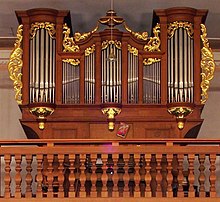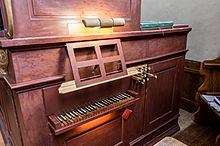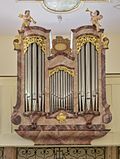Xaver Bernauer
Franz Xaver Bernauer (born December 3, 1768 in Staufen im Breisgau ; † February 3, 1831 ibid) was a German organ builder who was active in the transition from Baroque to Classicism .
Life
The organ expert Bernd Sulzmann (1940–1999) researched Bernauer's life and work and discussed them extensively in an article.
Xaver Bernauer was the only child of the organ builder Blasius Bernauer and his wife Maria Brendtlin. From his marriage to Ursula Müller from Staufen, whom he married there on August 24, 1795, no children emerged - at least according to the registry books in Staufen.
Xaver Bernauer learned the trade of organ builder from his father, whom he served as a full-fledged worker at the age of 14. From 1790 he ran the business, but because of the turmoil of the coalition wars, he was forced to work with a carpenter outside Staufen in Dattingen (district of Müllheim ). After returning to Staufen, he took on numerous assignments, where, like his father, he was active in a very large area of work, from Northern Switzerland to Ortenau and from Upper Alsace to Baar . “In the mostly poor communities, small, cheap and good organs were in demand, which Blasius and Xaver Bernauer could quickly come up with, as some instruments were already prefabricated in the workshop.” Xaver Bernauer was in need of support from 1817 to 1820, he in Gant (bankruptcy), after his death in 1831 his widow had to sell his “handicraft crockery” in order to be able to fulfill a legal title of the municipality of Tüllingen over 50 guilders .
The pastor and mayor of his hometown wrote in 1827: “As far as the skill of the organ maker Bernauer is concerned, there is no longer any doubt in this area or in the Oberland. There is general praise for the work he has delivered. ”Everywhere“ one is very satisfied with his work not only after it has been completed, but also up to this hour. ”However, Xaver Bernauer was unable to receive the order he was given to build an organ for the Martinskirche in Staufen to lock. “It's a shame,” noted the pastor in the book of the dead, “that this great artist, poor, in the middle of the construction of a local organ for this parish church, left this world.”
Works
Bernd Sulzmann comments on the fate of the works of Blasius and Xaver Bernauer: “There is not much left of the almost 70 years of activity of the organ maker. After all, these remains are sufficient to document their solid working methods also in our time and not to allow the masters to be completely forgotten. The tragedy of her life has carried over to her creations. ”The known remnants of Xaver Bernauer's instruments are listed according to their current locations:

St. Ilgen
In 1800 Xaver Bernauer was commissioned to build a new organ for the parish church of St. Cyriak in Sulzburg . There he found an instrument made by the organ builder Sebastian Fichslin (Füchslin) from around 1719. Using the existing case, he manufactured a new organ, which is now a listed building - the case is one of the oldest in Baden and the only visible memory of Sebastian Fichslin, and the organ itself, along with the one in Fischingen, is the most fully preserved work of Xaver Bernauer . From him coming "two bellows , both wind chests , the keyboards and Wella doors , the organ stops , the Trompetbaß and probably - archival without allocation - all metal pipes."
In 1965 GF Steinmeyer & Co. carried out a refurbishment of the old organ inventory, in which the principal pipes in the prospectus were replaced. In 1984 the organ was moved to St. Ilgen by the organ builder Peter Vier . On this occasion, the old hand-operated or foot-operated bellows were also reinstalled.
The instrument has 10 registers .
|
|
||||||||||||||||||||||||
According to the cantor, the sound of the organ is "typically baroque, with a sharp mixture."
Waldkirch
Xaver Bernauer built an organ for the parish church in Kappel , today a suburb of Freiburg , together with his father Blasius, who was here for the last time as a master . The remnants that remained after the construction of a new organ in 1898–1900 finally went to Bernd Sulzmann, who saved them from destruction. Completely restored and ready to play, the instrument stood in the auditorium of the Ettenheim elementary school from 1971 and has been in the organ builder's hall of the Waldkircher Organ Foundation since 2003. The original inventory is now limited to the case and the wind chest. According to the contract with the parish, an organ had to be built for 800 guilders with the following disposition (“The parish has the entire work on its cost, from Stauffen to Kappel, and at the same time to hand over food to H. Bernauer during the erection period "):
|
||||||||||||||||||
Giersberg Chapel, Kirchzarten-Giersberg
The facade of the organ, which Xaver Bernauer probably built in 1804/1805, has been preserved. The Waldkircher Orgelbau Jäger & Brommer recently restored it and placed it in front of their new organ in 1992. Two putti are attached to the case, copies of Matthias Faller's originals in the church of the former St. Peter's monastery .
Kirchzarten
Only the case of the organ built in 1804 for the parish church of St. Gallus has survived, but the original arrangement is also known.
|
|
||||||||||||||||||||||||||||
The organ builder Josef Merklin wrote in 1854: “This organ work is by a good master and the entire method of processing and technical equipment is good, only the disposition of the registers is as it was done 50 years ago when the work was built, namely it has a peculiar mix of tones in the mixture and has too few soft registers. ”When Willi Dold built a new organ in 1936, at least the wooden pipes were taken from the pedal in addition to the case: subbass, octave bass and flute bass. When the Metzler Orgelbau restored the instrument in 1991, the wooden pipes of the sub-bass were too badly damaged for further use and the others did not fit into the sound concept, so that they should possibly be used elsewhere; In addition to the case, only the flute bass 4 ′ from Xaver Bernauer is partially preserved, "not insignificant for Bernauer research."
Hochdorf
Xaver Bernauer's organ from 1804 for the parish church of St. Martin in what is now the suburb of Freiburg was lost in 1913 when it was rebuilt. Only the “broad-based organ case, which is now again splendid to look at, in the latest baroque forms has been preserved. Three inscription tablets there still tell of the construction of the first organ: 'Xaver Bernauer Orgelbauer in Staufen.1804'. ”Organ builder Johannes Rohlf restored the case in 1975 on the occasion of the installation of a new organ.
Wettelbrunn
From Xaver Bernauer's organ from 1808, only the case in the St. Vitus church has survived, which Sulzmann sees as being designed according to a “model” by Johann Andreas Silbermann , as he realized it in Griesheim , St. Quirin or Saverne . However, the original disposition is also known:
|
|
||||||||||||||||||||||||
Fischingen
The organ, built in 1810/1811, is a listed building. In 1950 it was restored by Eberhard Friedrich Walcker , Ludwigsburg, and again in 1971/72 by Peter Vier from Oberweier. On this occasion she was moved from the gallery to the choir room. It has a mechanical sliding drawer, mechanical play and stop action, a manual on the side of the instrument, attached pedal and 8 stops. It thus corresponds to the "Upper Rhine organ type" which "provides 8-15 stops for a village church organ and, with optimal scaling (free of any objection from God-gifted experts), enables a balanced tonal statement that can hardly be surpassed." Also, "Xaver's little organ is in Fischingen well thought out with eight registers. ”The contract with the municipality for a purchase price of 635 guilders was concluded on September 18, 1810. The organ could already be picked up in Staufen in November because it was largely prefabricated. It is the only almost completely preserved instrument by this master.
|
||||||||||||||||||
Sissach
Large, two-manual organs were reserved for monasteries on the Upper Rhine until around 1800 because the communities had not yet recovered from the Thirty Years' War and the wars that followed. Xaver Bernauer was only able to build a single organ with two manuals, which is indicative of a place in Switzerland. The contract with the Reformed parish of St. Jakob in Sissach was signed on April 16, 1818 for a purchase price of 1,588 guilders. The community was very suspicious during the construction period and paid out advances to Xaver Bernauer only very hesitantly, “because there were all sorts of bad rumors about him, as if he were a dissolute housekeeper.” But in October 1820, “Organ maker Bernauer came with his companion and one Apprentices. [...] He then stayed here until the inauguration of the organ on October 7, 1821. [...] Thus all distrust of Mr. Bernauer completely ceased. "
In 1957 it was said: “The current old organ, which is part of the late Gothic choir, has been thoroughly checked and may no longer be considered a suitable instrument. Its inadequacies are too great for a renovation with a fresh sound to be thought of. From this situation one clearly comes to the conclusion that a new instrument should be created within a reasonable period of time, provided that one does not want to risk undesirable disturbances in the church service and concert. ”The organ was in the choir of the church because one was there in the course of its In addition, a gallery had been installed in the superstructure so that no one had to stand in front of the door when a church visit was mandatory. Since this situation had changed in 1965, the choir loft could be removed and the organ moved to the loft in the nave during the restoration by Orgelbau Kuhn . It was then decided, however, not only to preserve the case, but also the prospect pipes, namely the part of the principal 8 'that is in the prospectus of the organ and the part of the montre (principal) 4' that is in the back positive.
|
|
|
||||||||||||||||||||||||||||||||||||||||||
Staufen
“The miserable condition and complete disintegration of our organ” made it necessary, in the opinion of the pastor, as early as 1817 “not only to point to the production of our new organ, but to take every possible step towards it. Since our fellow citizen, X. Bernauer, is a skilled organ maker, a good work could also be expected from him ”. However, the contract was only concluded in 1828. Because of the organ builder's dubious financial situation, it was "decided to buy the organ builder Bernauer all the necessary materials for the organ in the form of wood, pewter and leather from the town of Casse, or the organ money in stock, and to give him a weekly wage, who is proportionate to his expenses to be thrown out and paid out ”. The work was never completed, but the planned disposition of the organ is known from the parish archives.
|
|
||||||||||||||||||||||||||||||||||||
Appreciation
Bernd Sulzmann sees Xaver Bernauer as a victim of the political changes as a result of the French Revolution, which would not have made it possible for him to build up his own solid business at a young age. Since he worked too cheaply and had to help feed his father, he was unable to gather wealth. “As is the case with many artists,” wrote the pastor and mayor of Staufen in 1827, “because he looked more at good, long-term work than at its benefits, and therefore made losses on some accords, he fell into financial decline . "Bernd Sulzmann sums up his assessment of the two masters Bernauer:" It will always remain incomprehensible to posterity how these artists in their poverty could deliver cheap and dignified instruments that still delight today, "whereby Xaver Bernauer even surpassed his father as an artist have.
List of works
In addition to repair work and new construction projects that did not result in orders, Bernd Sulzmann lists the organs newly built by Xaver Bernauer:
| year | place | church | image | Manuals | register | Remarks |
|---|---|---|---|---|---|---|
| 1795 | Blansingen | Peterskirche | I / P | 11 | Not received | |
| 1797/1798 | Weir | St. Martin | Not received | |||
| 1797/1799 | Egringen | Evangelical Church Egringen | I / P | 12 | Not received | |
| 18 .. | Hag | Not received | ||||
| 1800 | Sulzburg | St. Cyriak | I / P | 10 | The largely preserved organ, the case of which does not come from Xaver Bernauer, has been in the Church of St. Egidius in St. Ilgen since 1974 | |
| 1801 | Chapel | St. Peter and Paul | I. | 8th | The last organ in which Blasius Bernauer can still be proven as an employee. Housing and wind chest are preserved. Today's location: Organ builders' hall of the Waldkirch Organ Foundation | |
| 1804 | Hochdorf | St. Peter and Paul | Housing is preserved | |||
| 1804/1805 (?) | Kirchzarten | Giersberg Chapel | The facade is preserved | |||
| 1804/1805 | Kirchzarten | St. Gallus |

|
I / P | 12 | Housing and part of the Flötbass 4 'are preserved |
| 1807 | Stone city | St. Barbara | I / P | 12 | Not received | |
| 1808 | Wettelbrunn | St. Vitus |

|
I / P | 11 | Housing received |
| 1809/1810 | Todtnau | St. John the Baptist | I / P | 12 | Not received | |
| 1810 | Fischingen | Evangelical Church Fischingen | I / p | 8th | Prefabricated organ, almost completely preserved | |
| 1813 (?) | Basel | St. Alban | Not received | |||
| 1813 | Grunts | St. Agatha | I. | 11 | Not received | |
| 1816 | Schlatt | St. Sebastian | Not received | |||
| circa 1817 | Basel | Martinskirche | Not received | |||
| 1818/1821 | Soelden | St. Fides and Mark | Not received | |||
| 1818/1821 | Sissach | St. Jacob | II / P | 17th | The only two-manual organ by Xaver Bernauer. The case and the prospect pipes have been preserved | |
| 1818/1819 | Todtnauberg | St. James the Elder | I. | 5 | Not completed, not received | |
| 1828/1831 | Staufen | St. Martin | I / P | 16 | Not finished, not received |
literature
- Bernd Sulzmann: Sources and documents about the life and work of the organ maker family Bernauer-Schuble in the Markgräflerland. In: Acta Organologica Volume 13, 1979, pp. 124-192.
Individual evidence
- ↑ Bernd Sulzmann: Sources and documents about the life and work of the organ maker family Bernauer-Schuble in the Markgräflerland. In: Acta Organologica Volume 13, 1979, pp. 124-192.
- ↑ Sulzmann, 1979, p. 126.
- ↑ Sulzmann, 1979, p. 132.
- ↑ Sulzmann, 1979, p. 142.
- ↑ Sulzmann, 1979, p. 152.
- ^ Bernd Sulzmann: Historical organs in Baden. Schnell & Steiner, Munich 1980, ISBN 3-7954-0421-5 , p. 28.
- ^ Helm, p. 382.
- ↑ Sulzmann inadvertently does not perform the flute in historical organs in Baden , so that based on this, Helm only gives 9 registers.
- ↑ The appeal of the tonal comparison. In: Badische Zeitung, June 22, 2011 (online)
- ↑ Bernauer, 1979, p. 174.
- ↑ Quoted in Sulzmann: Historische Orgeln in Baden , p. 140.
- ^ Sulzmann, as above.
- ^ Hermann Brommer : Catholic parish church St. Martin Hochdorf (Freiburg im Breisgau). Munich 1977. (online)
- ↑ Sulzmann, 1979, p. 143.
- ↑ Bernd Sulzmann: Freiburg organ maker of the 17th, 18th and 19th centuries. In: Schau-ins-Land, 98, 1979, p. 82 f. (on-line)
- ↑ Sulzmann, 1979, p. 143
- ↑ Possibly a typo so that it should have been 1 1 1 ⁄ 3 ′.
- ↑ Sulzmann, 1979, p. 132.
- ↑ Sulzmann, 1979, p. 128.
| personal data | |
|---|---|
| SURNAME | Bernauer, Xaver |
| ALTERNATIVE NAMES | Bernauer, Franz Xaver (full name) |
| BRIEF DESCRIPTION | German organ builder |
| DATE OF BIRTH | December 3, 1768 |
| PLACE OF BIRTH | Staufen im Breisgau |
| DATE OF DEATH | February 3, 1831 |
| Place of death | Staufen im Breisgau |









